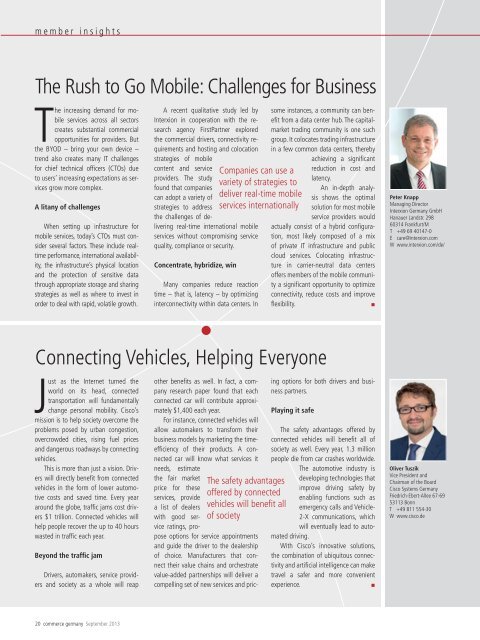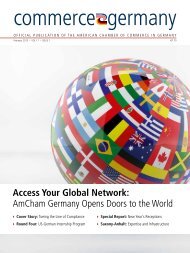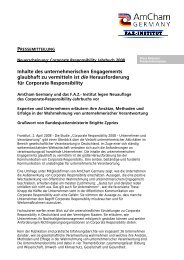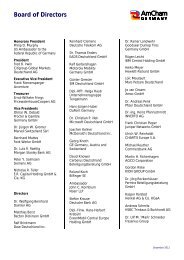Issue 4 - AmCham Germany
Issue 4 - AmCham Germany
Issue 4 - AmCham Germany
Create successful ePaper yourself
Turn your PDF publications into a flip-book with our unique Google optimized e-Paper software.
member insights<br />
The Rush to Go Mobile: Challenges for Business<br />
The increasing demand for mobile<br />
services across all sectors<br />
creates substantial commercial<br />
opportunities for providers. But<br />
the BYOD – bring your own device –<br />
trend also creates many IT challenges<br />
for chief technical officers (CTOs) due<br />
to users’ increasing expectations as services<br />
grow more complex.<br />
A litany of challenges<br />
When setting up infrastructure for<br />
mobile services, today’s CTOs must consider<br />
several factors. These include realtime<br />
performance, international availability,<br />
the infrastructure’s physical location<br />
and the protection of sensitive data<br />
through appropriate storage and sharing<br />
strategies as well as where to invest in<br />
order to deal with rapid, volatile growth.<br />
A recent qualitative study led by<br />
Interxion in cooperation with the research<br />
agency FirstPartner explored<br />
the commercial drivers, connectivity requirements<br />
and hosting and colocation<br />
strategies of mobile<br />
content and service<br />
providers. The study<br />
found that companies<br />
can adopt a variety of<br />
strategies to address<br />
the challenges of delivering<br />
real-time international mobile<br />
services without compromising service<br />
quality, compliance or security.<br />
Concentrate, hybridize, win<br />
Many companies reduce reaction<br />
time – that is, latency – by optimizing<br />
interconnectivity within data centers. In<br />
Companies can use a<br />
variety of strategies to<br />
deliver real-time mobile<br />
services internationally<br />
some instances, a community can benefit<br />
from a data center hub. The capitalmarket<br />
trading community is one such<br />
group. It colocates trading infrastructure<br />
in a few common data centers, thereby<br />
achieving a significant<br />
reduction in cost and<br />
latency.<br />
An in-depth analysis<br />
shows the optimal<br />
solution for most mobile<br />
service providers would<br />
actually consist of a hybrid configuration,<br />
most likely composed of a mix<br />
of private IT infrastructure and public<br />
cloud services. Colocating infrastructure<br />
in carrier-neutral data centers<br />
offers members of the mobile community<br />
a significant opportunity to optimize<br />
connectivity, reduce costs and improve<br />
flexibility.<br />
<br />
Peter Knapp<br />
Managing Director<br />
Interxion <strong>Germany</strong> GmbH<br />
Hanauer Landstr. 298<br />
60314 Frankfurt/M<br />
T +49 69 40147-0<br />
E care@interxion.com<br />
W www.interxion.com/de/<br />
Connecting Vehicles, Helping Everyone<br />
Just as the Internet turned the<br />
world on its head, connected<br />
transportation will fundamentally<br />
change personal mobility. Cisco’s<br />
mission is to help society overcome the<br />
problems posed by urban congestion,<br />
overcrowded cities, rising fuel prices<br />
and dangerous roadways by connecting<br />
vehicles.<br />
This is more than just a vision. Drivers<br />
will directly benefit from connected<br />
vehicles in the form of lower automotive<br />
costs and saved time. Every year<br />
around the globe, traffic jams cost drivers<br />
$1 trillion. Connected vehicles will<br />
help people recover the up to 40 hours<br />
wasted in traffic each year.<br />
Beyond the traffic jam<br />
Drivers, automakers, service providers<br />
and society as a whole will reap<br />
other benefits as well. In fact, a company<br />
research paper found that each<br />
connected car will contribute approximately<br />
$1,400 each year.<br />
For instance, connected vehicles will<br />
allow automakers to transform their<br />
business models by marketing the timeefficiency<br />
of their products. A connected<br />
car will know what services it<br />
needs, estimate<br />
The safety advantages<br />
offered by connected<br />
vehicles will benefit all<br />
of society<br />
the fair market<br />
price for these<br />
services, provide<br />
a list of dealers<br />
with good service<br />
ratings, propose<br />
options for service appointments<br />
and guide the driver to the dealership<br />
of choice. Manufacturers that connect<br />
their value chains and orchestrate<br />
value-added partnerships will deliver a<br />
compelling set of new services and pricing<br />
options for both drivers and business<br />
partners.<br />
Playing it safe<br />
The safety advantages offered by<br />
connected vehicles will benefit all of<br />
society as well. Every year, 1.3 million<br />
people die from car crashes worldwide.<br />
The automotive industry is<br />
developing technologies that<br />
improve driving safety by<br />
enabling functions such as<br />
emergency calls and Vehicle-<br />
2-X communications, which<br />
will eventually lead to automated<br />
driving.<br />
With Cisco’s innovative solutions,<br />
the combination of ubiquitous connectivity<br />
and artificial intelligence can make<br />
travel a safer and more convenient<br />
experience.<br />
<br />
Oliver Tuszik<br />
Vice President and<br />
Chairman of the Board<br />
Cisco Systems <strong>Germany</strong><br />
Friedrich-Ebert-Allee 67-69<br />
53113 Bonn<br />
T +49 811 554-30<br />
W www.cisco.de<br />
20 commerce germany September 2013













